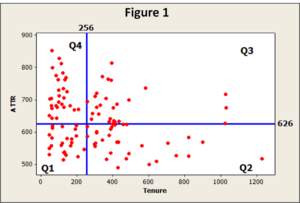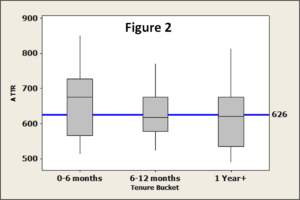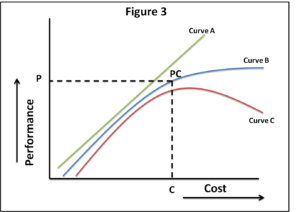A lot of has been written about employee attrition in call centers. Call Centers have a relatively high employee attrition rate compared to other industries. Companies invest a lot of efforts and resources to retain call center executives. While working on an employee engagement and development plan last week, one of the participants surprised us with this question:
“What is the SHELF LIFE for a Call Center Executive?”
When is it a good time to let go an employee irrespective of his performance? If and when that needs to be done, what choices do we have?
Before we could even think about the possible outcomes and choices, we had to answer the first question. We collected employee tenure and performance data for a technical support process.
Data Collected
| Data | Description |
| Tenure of the Employee | Number of days an employee had worked for the process after completing the new hire training |
| Average Handle Time (AHT) | Average time taken to complete one call (average of last 3 months) |
| First Call Resolution (FCR) | Percentage of customer queries resolved in the first interaction (average of last 3 months) |
There were 109 employees in the process:
0-6 months: 46, 6-12 months: 24, More than a year: 39
By looking at the graph below (Figure 1: Scatter Plot of ATTR vs. Tenure), it can be said that tenure does not guarantee optimum performance levels.

There is always a learning curve and performance improves as employees learn while in the job, however after a certain point, the learning curve either gets flat or starts going in the reverse direction. The employees in Quadrant 3 (Q3) in Figure 1 are the ones that have been with the process for more than 256 days (median for employee tenure) and yet have an ATTR of more than 626 seconds (median for ATTR). These employees have a higher cost per head for the company but their average revenue per head is comparatively low than other employee groups (Q1, Q2 and Q3).
The graph below (Figure 2: Boxplot of ATTR) displays the ATTR distribution for the three employee groups (0-6 months, 6-12 months and 1 Year+). There is no significant difference in performance when we compare the 2nd and the 3rd groups.

As the data reflects, tenure would not always have a strong positive correlation with performance and hence the cost. The curve either gets flat or in the worst cases which every manager would fear the most, it goes downhill.
So when do we decide if we should let go an employee and if we do, what are the possible options?
First we need to figure out the optimum performance level and the subsequent cost per transaction. Given below (Figure 3: Cost vs. Performance) is an illustration of employee performance against the cost per transaction. At any point, irrespective of the tenure, for a performance level “P”, the cost per transaction should be less than “C”. Rather than absolute points, there would be a range, so it would beCmin and Cmax for instance.

When we decide to let go an employee, what options do we provide him or her? This is the trickiest part. An employee with an at-par performance is being asked to leave because his or her salary and benefits exceed the acceptable levels. I have not yet come to an appropriate answer or solution, would love to have some insights on this. However, given below are some thoughts to consider:
- Determining the highest salary bracket for a particular job. Irrespective of how long the employee stays with the company, no annual raise beyond a certain limit. However, this would be applicable only if the employee manages to sustain the performance levels (Curve B in Figure 3)
- Career guidance and development programs for employees to prepare them for other key roles within the Organization (This happens in most of the Organizations however this could become an eliminator – an employee needs to get through the career plan with all the support or else he or she should be asked to leave)
- Assistance with Higher Studies and Placement: Once again, most organizations have in-house assistance programs that motivate employees to enrol for higher studies. Going one step further, companies should provide job and placement assistance for employees who clear the exams and cannot be absorbed within the organization


Heya i’m for the first time here. I found this board and I find It really useful & it helped me out much. I hope to give something back and help others like you aided me.
pleasant post and extremely helpful thanks a lot designed for posting